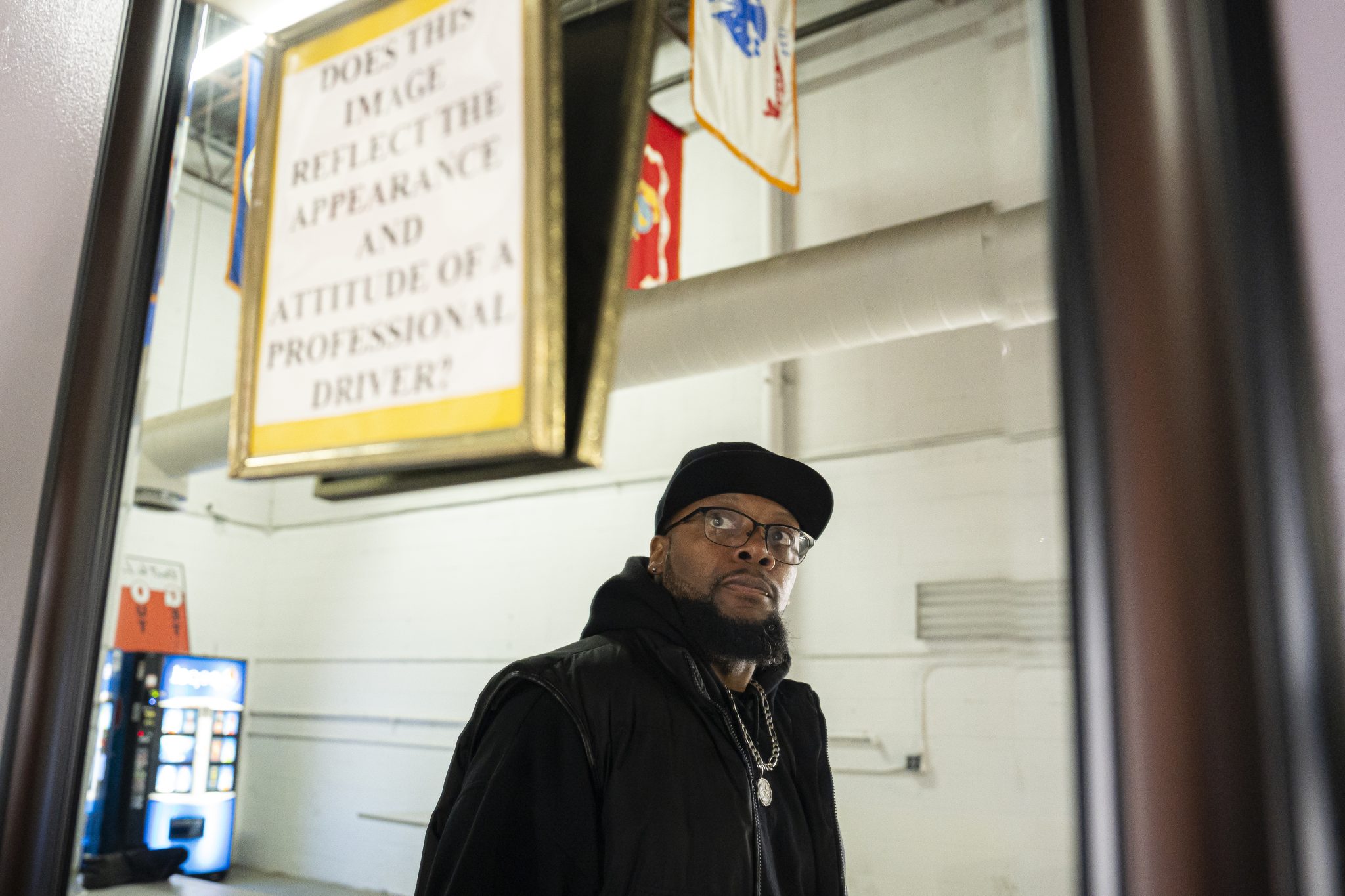When Yusef Qualls-El was 17, a judge sentenced him to life behind bars. It was the mid-1990s, an era when the U.S. prison population exploded.
Thousands of minors like Qualls-El received sentences of life without parole and entered prison at an age when their peers were going to college or starting their careers. But inside, education is often reserved for those who will soon return to society. As a result, those who were seen as the least likely to get out had the fewest opportunities.
Now, as courts and lawmakers have begun to rethink extreme sentencing policies for young people, thousands of those sentenced to spend their lives in prison are getting out. Suddenly, people who went to prison as teenagers are being released as middle-aged men and women.
Building a living-wage career — let alone going to school — often seems out of reach for people like Qualls-El, a 44-year-old with a criminal history and no formal education beyond a GED.

Amanda J. Cain/Open Campus Media
Yusef Qualls-El, 44, visits Suburban Truck Center in Romulus, Mich. on March 14, 2024. He recently earned his commercial drivers license after completing driver training at the school. Inspirational quotes are located around the facility.
After he was resentenced in 2022, Qualls-El was still told no when he wanted to enroll in college. He didn’t have enough time left on his sentence to finish a degree.
“I’ve spent 27-plus years plus in prison, hoping to get some sort of education, but wasn’t allowed, because of how much time I had left,” Qualls-El said on a call from prison at the end of 2022, about six months before he was released. “Now I have too little time.”
College is still something Qualls-El says he wants to do but he knows it will take some time. Before his release in June 2023, he wanted to earn a business degree to become an entrepreneur. But now, his priority is getting a job.
A recognition that kids are different
Qualls-El was convicted in 1995 of two counts of first-degree murder, and sentenced to mandatory life without parole in connection to shooting deaths of two people. He has maintained he was not the shooter, but Michigan law makes no distinction between the person who pulled the trigger and others who are present when a crime was committed. His sentence began not long after Congress passed the 1994 crime bill, which gutted most of the country’s prison education programs through the elimination of federal financial aid for incarcerated students. Although the national incarceration rate had been steadily increasing for decades, federal and state tough-on-crime policies dramatically increased the U.S. prison population.
Between 1995 and 2017, 11,600 individuals serving life without the possibility of parole were under 26 at the time of their sentence, according to a recent analysis by the Sentencing Project, a research and advocacy organization. Two-thirds were Black. And thousands more teenagers and young adults across the country were handed down sentences so long that they would die behind bars.
Things began to change as courts began to consider research that showed young people’s brains are not the same as older adults. Following a series of Supreme Court decisions between 2005 and 2016 that found juvenile life without parole was cruel and unusual, states began changing sentencing guidelines that automatically sent young people to prison for life. In 2016, the court ruled that those new guidelines should be applied retroactively, opening the door for juvenile lifers like Qualls-El to be resentenced.
Today, more than half of states have banned life sentences without the possibility of parole for people under 18. Some places, such as Washington D.C. and Michigan, have even begun to resentence those who were young adults when they committed their crimes. In January, Massachusetts became the first state to ban life without parole from people under 21.
While the sentencing reform means that thousands of people now have the opportunity to go before a judge, it doesn’t mean they are immediately being released, said Ashley Nellis, co-director of research at the Sentencing Project. Still, she said, policymakers need to be prepared to support this population as more people start to come home.
Limited education inside
While Qualls-El was in prison, Michigan excluded lifers from most educational opportunities. That’s not an anomaly. As of 2020, half of states imposed restrictions on participation in education based on the length of a person’s sentence, according to the Council of State Governments Justice Center.
In 2023, Michigan changed its policies to allow people with long sentences to access education following the return of Pell Grants for incarcerated people. About 130 students who are serving a sentence of life without the possibility of parole are now in college programs in the state, according to the Michigan Department of Corrections. That’s about 15 percent of the total student population inside.
But those who went to prison during the 1990s and 2000s came of age inside, missing out on key milestones. They often heard the same thing: Why should the state waste resources on educating them when they would never return to society?
As Qualls-El was trying to navigate an adult prison as a teenager, he was also trying to finish high school. But because he had no release date, he says he was always at the bottom of the waiting list.
“They didn’t want to put me in school at all,” he said. “But I convinced them to allow me to take my GED.”
He scored high enough on the high school equivalency exam to pass on the first try in 1998. That was the last formal credential that he earned during his 28-year incarceration, he said, aside from a food handler’s permit that only had a year of eligibility after he got out.
He did receive a range of certificates for completing limited programming run by the corrections department on things like food technology, hospitality and management, digital literacy and “Money Smart Computer Based Instruction.” The state of Michigan also gave him a “certificate of employability” signed by the corrections department education director when he was released. The certificate is intended to “help remove the stigma associated with hiring these citizens and eliminate the risk for employers,” according to the corrections department website.
While industry-recognized credentials can help improve employment options for formerly incarcerated people, certificates issued by corrections departments can have the opposite effect: indicating applicants’ criminal histories to employers, which could limit opportunities. One study found that there were nearly 14,000 laws and regulations that can restrict people with criminal histories from getting professional licenses, which are required for jobs ranging from health care to cosmetology.
Qualls-El’s only choicewas to take charge of his own intellectual development, he said. He read, wrote and published poetry, and developed his artistic skills. He participated in the University of Michigan’s Prison Creative Arts Project, which puts on public exhibitions of work by incarcerated artists.
Lifers like Qualls-El who were released after decades in prison have one of the lowest recidivism rates of any group, according to several studies. Tarika Daftary-Kapur’s research on Philadelphia, which had the country’s highest number of juvenile lifers in the country at the time of the 2016 Supreme Court ruling, found that fewer than 1.5 percent were convicted again. Overall, about 40 percent of people who are released from prison go back within three years.
There’s also a psychological effect of getting out after thinking you never would, said Daftary-Kapur, a professor of justice studies at Montclair State University.
“Many of them look at this as the second chance they never thought they were going to get,” she said. “And it’s not something that they want to give up.”
Nevertheless, there’s still a sense of loss. It’s really hard to catch up for that lost time and lost ability. “I like to say they can’t reach their full potential.”
Success, she added, is about more than just not going back to prison.
The value of a degree in reentry
In the months before his release, Qualls-El wanted to enroll in a university program when he got out. But he quickly realized that balancing school and work — while also trying to rebuild his life — wasn’t realistic. Formerly incarcerated people are eight times less likely to complete college than the general public, according to the Prison Policy Initiative.
If he could have worked toward a degree during his 28 years inside, he said, he would be in a much better position to start his own business, which is his ultimate goal. It also could have eased his job search.

Amanda J. Cain/Open Campus Media
Yusef Qualls-El, who goes by “Q”, looks out of the driver side window of one of the one of the trucks at the Suburban Truck Center in Romulus, Mich., where he did truck driver training. Qualls-El was largely shut out of educational opportunities during his 28-year incarceration in Michigan, but he’s now earned a commercial drivers license and hopes to become an entrepreneur.
“There’s already a stigma attached to coming out of prison, so coming out of prison without an education limits my job prospects,” Qualls-El said. “Some of the jobs that were available to me were $11 an hour. How is a grown man supposed to support himself, really?”
For now, he’s found a promising path. After enrolling in truck driver training last fall, he earned his commercial driver’s license at the end of February.
Within two weeks, he found a job.
***
Charlotte West is a Open Campus national reporter covering the future of postsecondary education in prison. Her work has appeared in national publications such as The Hechinger Report, the Washington Post, Teen Vogue and NBC.
OpenCampus is a nonprofit news organization dedicated to investigating and elevating higher education. OpenCampus operates as a cooperative model for in-depth reporting partnering with local newsrooms to deliver expert coverage of higher education for communities.
This story was co-published by OpenCampus and The Washington Post.


























